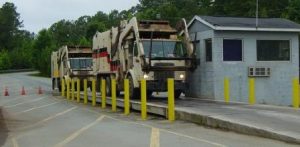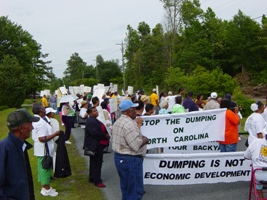Race, wealth, and solid waste facilities in North Carolina
Lead Investigator: Jennifer Norton, PhD
What’s going on?
 North Carolina citizens have expressed concern that landfills and other solid waste facilities may be harmful to their health and that communities of color and low wealth may bear more than their share of the burden of that waste. Proposed new mega-landfills would make the state a major importer of waste from other states.
North Carolina citizens have expressed concern that landfills and other solid waste facilities may be harmful to their health and that communities of color and low wealth may bear more than their share of the burden of that waste. Proposed new mega-landfills would make the state a major importer of waste from other states.
This research study, the first of its kind in the state, tried to discover whether landfills were more often located in communities of color and low wealth than in other communities.
What was done?

Researchers gathered information about the location of solid waste facilities from state permit records. They compared this to information from the US Census Bureau about race and economic characteristics.
The researchers did special analyses of data from 1990-2003 to understand whether people of color and low-wealth communities are more often selected for solid waste facilities.
What was found?

By the end of 2003, 419 solid waste facilities had been issued permits to operate. Almost half of these (201) were municipal solid waste landfills. The study found that communities of color and low wealth were more likely to live with a landfill than other communities.
Communities with 50% people of color or more were 2.8 times more likely to have a solid waste facility than communities with less than 10% people of color .
People living in places with average (median) house values of <$60,000 were 1.5 times more likely to have a solid waste facility than people in areas with average values of $100,000 and greater.
Between 1990 and 2003, permits were issued for 207 new solid waste facilities. Among communities that did not previously have a facility, new facilities were permitted 2.7 times more often in communities with more than 50% people of color compared to communities with less than 10% people of color. New privately-owned waste facilities were more likely to be permitted in communities of color; however, the same was not true of publicly-owned facilities.
What it means
 Results of this study validated citizen concerns that communities of color and low wealth are more often exposed to solid waste facilities than other communities.
Results of this study validated citizen concerns that communities of color and low wealth are more often exposed to solid waste facilities than other communities.
Communities that host solid waste facilities face concerns about truck traffic, odor, noise, air and water pollution. Waste sites may attract other waste facilities, affect property values, and make communities less desirable locations for clean industry.
Imposing the burden of waste on vulnerable groups in our society is bad for all people because it does not cause the greatest producers of waste to be confronted with the results of their consumption and waste production. As a result, they have less incentive to take action to reduce their waste problem through reducing, reusing, and recycling.
Reference
Norton, J.M., Wing, S., Lipscomb, H.J., Kaufman, J.S., Marshall, S.W., & Cravey, A.J. (2007). Race, Wealth, and Solid Waste Facilities in North Carolina. Environmental Health Perspectives, 115(9): 1344-1350.
What is community driven research?
|
NC Environmental Justice Network, NC Fair Share, and UNC School of Public Health seek to make an impact on unjust patterns of environmental contamination through a partnership in research. This study was inspired by community concerns. The Holly Springs Chapter of North Carolina Fair Share helped to secure funding for the research.
|

|


